Pagurus hirsutiusculus (Dana, 1851)Common name(s): Hairy hermit crab |
|
| Synonyms: Pagurus (Eupagurus) mertensi, Bernhardus hirsutiusculus, Eupagurus hirsutiusculus, Pagurus (Trigonocheirus) hirsutiusculus, Eupagurus mertensi | 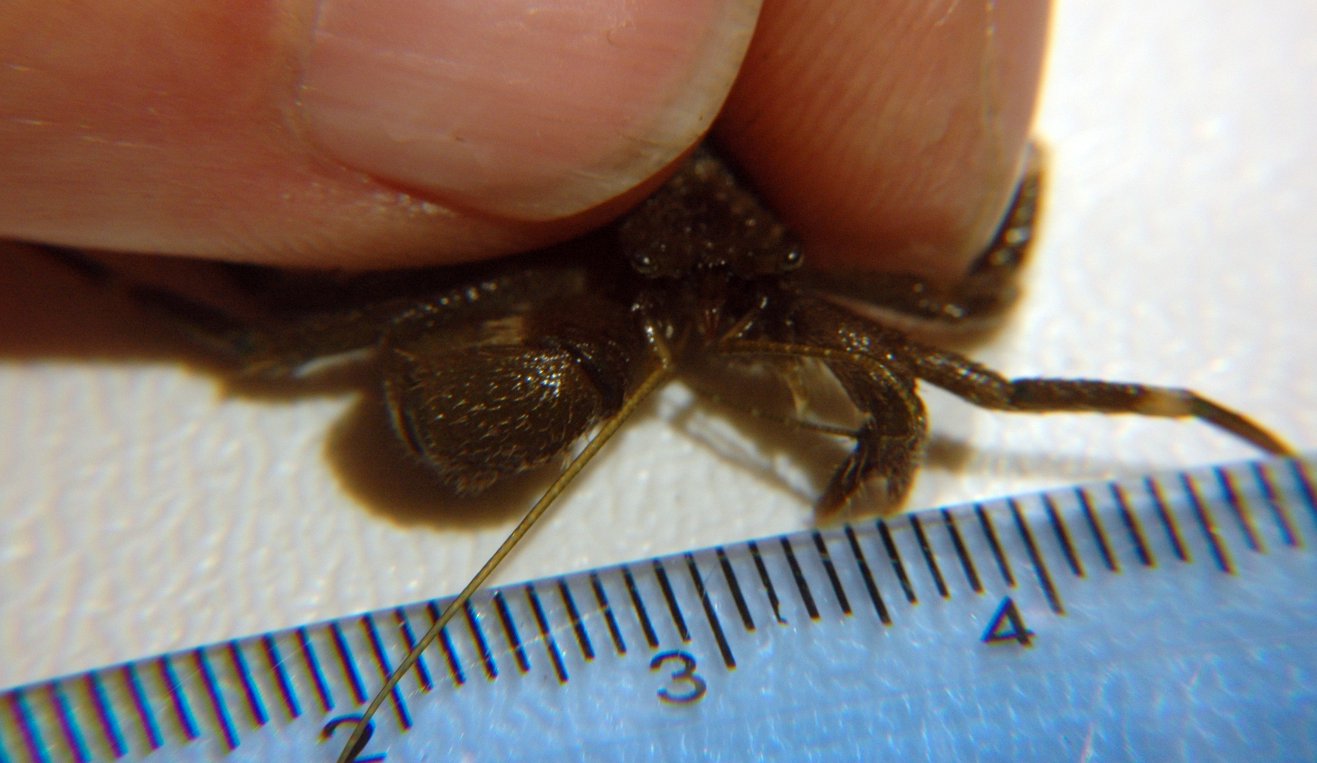 |
| Phylum Arthropoda
Subphylum Crustacea Class Malacostraca Subclass Eumalacostraca Superorder Eucarida Order Decapoda Suborder Pleocyemata Infraorder Anomura Superfamily Paguroidea Family Paguridae |
|
| Pagurus hirsutiusculus from the Rosario area | |
| (Photo by: Dave Cowles, August 2005) | |
How to Distinguish from Similar Species: Pagurus hemphilli is mostly similar but has orange-red antennae. Of the very common intertidal species, P. granosimanus has olive-green legs with small blue dots. P. samuelis has a bright blue dactyl on legs 2 and 3 instead of just a blue band, plus it occurs mainly on the open coast. P. caurinus is often mistaken for a small P. hirsutiusculus, but P. caurinus has spines on its chelae and its 2nd antennae are reddish brown without spots.
Geographical Range: Pribilof Islands, Alaska to Monterey, CA; Siberia, Japan; smaller and less hairy south of Puget Sound, and even more so south of Monterey Bay. Common in San Francisco Bay.
Depth Range: Intertidal to 110 m
Habitat: Intertidal tide pools and under rocks and algae, more abundant in protected water.
Biology/Natural History: This species is less resistant to emersion than is P. granosimanus, but it is more tolerant of brackish water. Many occupy small, light shells which they cannot completely retract into. They will also abandon their shell more readily than do some other species, such as P. granosimanus (photo), sometimes even when they are berried (carrying eggs (photo). They seem to have definite shell preferences, but these may be different in different places. Favorites include Nucella lamellosa, Searlesia dira, Littorina spp, and Olivella biplicata shells. Diet is mainly detritus, though they will eat live prey opportunistically. It is known to feed on hatchlings of Nucella emarginata, which lay and attach their eggs in the low intertidal. Predators include sculpins. Females become ovigerous in late fall and carry a total of about 5 broods through spring and summer. Parasites include the parasitic barnacles Peltogaster paguri and Peltogastrella gracilis and the bopyrid isopod Pseudione giardi.
Hermit
crabs in some families such as Paguridae tend to walk forward,
while the large majority and abundant species of true (Brachyuran)
crabs walk sideways. In a 2025 preprint, Taniguchi et al.
speculate that the sideways walking in so many true crab species is is
because walking sideways allows for rapid escape locomotion options in
two directions, providing a selective advantage.
| Return to: | |||
| Main Page | Alphabetic Index | Systematic Index | Glossary |
References:
Dichotomous Keys:Coffin, 1952
Flora and Fairbanks, 1966
Hart, 1982
Kozloff 1987, 1996
Smith and Carlton, 1975
Wicksten, 2009
General References:
Brusca
and Brusca, 1978
Harbo,
1999
Jensen,
1995
Johnson
and Snook, 1955
Kozloff,
1993
Morris
et al., 1980
O'Clair
and O'Clair, 1998
Ricketts
et al., 1985
Sept,
1999
Scientific Articles:
Taniguchi, Cunya, Tsubasa Inoue, Kano Kohara, Jung-Fu Huang, Atsushi Hirai, Nobuaki Mizumoto, Fumio Takeshita, and Yuuki Kawabata, 2025. Evolution of Sideways locomotion in crabs (Preprint). doi:
General Notes and Observations: Locations, abundances, unusual behaviors:
Although Pagurus hirsutiusculus is
often the most common intertidal
hermit crab in this region, we find few of these on Sares
Head. Perhaps
this is because P. hirsutiusculus is most common in
the mid-intertidal
and Sares Head has few tide pools except in the very low
intertidal.
There are plenty of rocks they could hide beneath, though.
They are
much more common on the protected side of Fidalgo Island, around rocks
in Padilla Bay.

Another individual from Sares Head.

The carapace
of P. hirsutiusculus has setae
but no spines. The front part (shield),
which is the only part which is calcified, is about as wide as it is
long.
In this photo the
shield
of the carapace
is to the top right, behind the eyestalks.
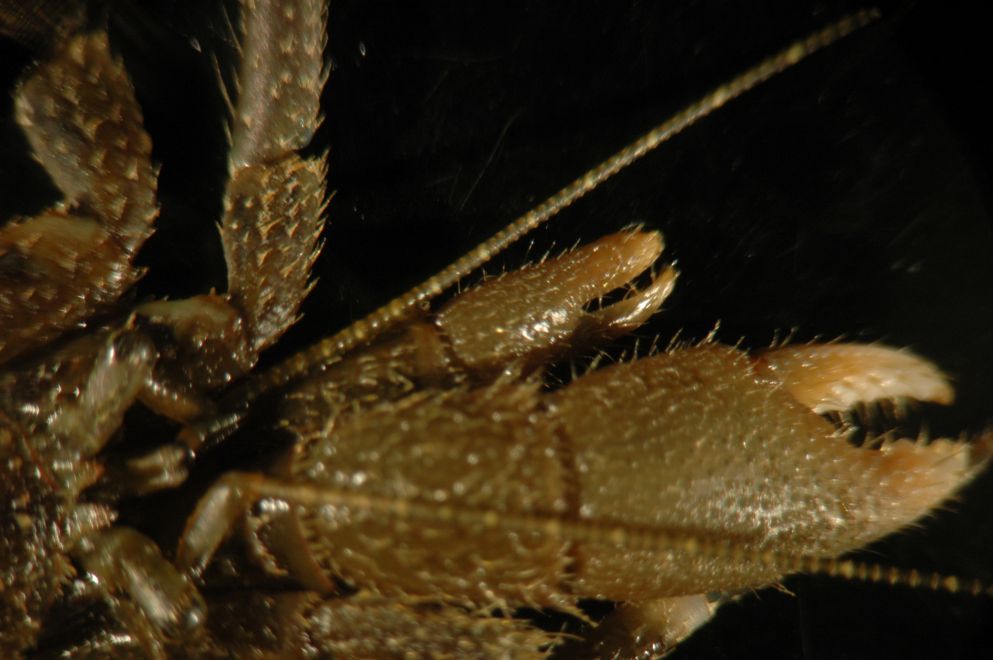
In this view of the chelae,
legs, and second antennae, one can see the setae
which cover the chelae
and legs, the larger right chela
which is characteristic of Pagurus,
and the fact that the carpus
of the right chela
is slightly longer than wide and it is not flattened. The
antennae
are green with white bands.
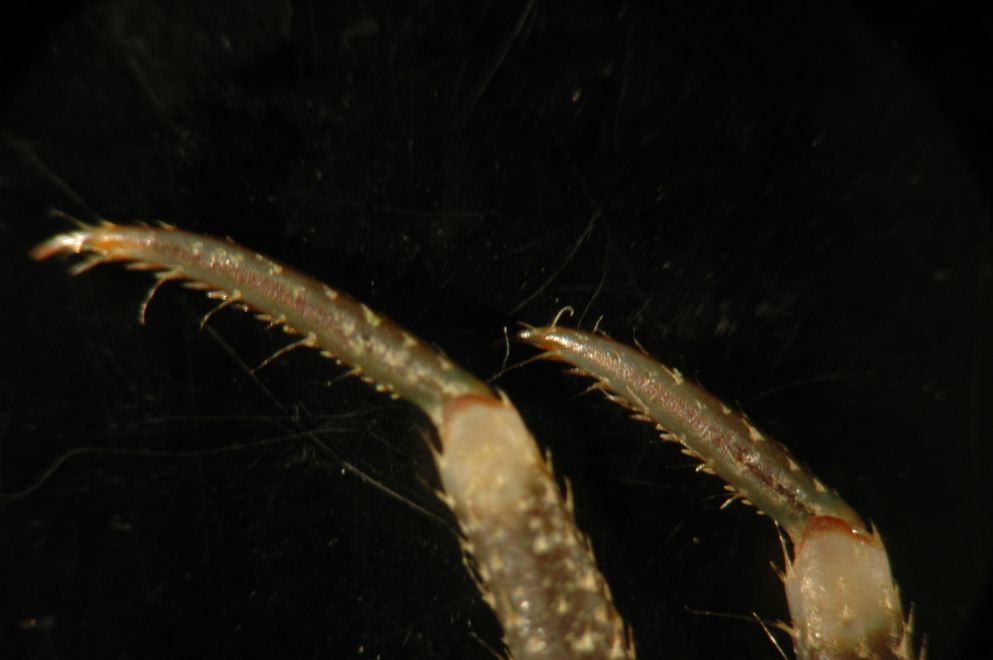
The dactyls
of legs 2 and 3 are not twisted, and there is a white (or blue) band at
the junction of the propodus
and dactyl.
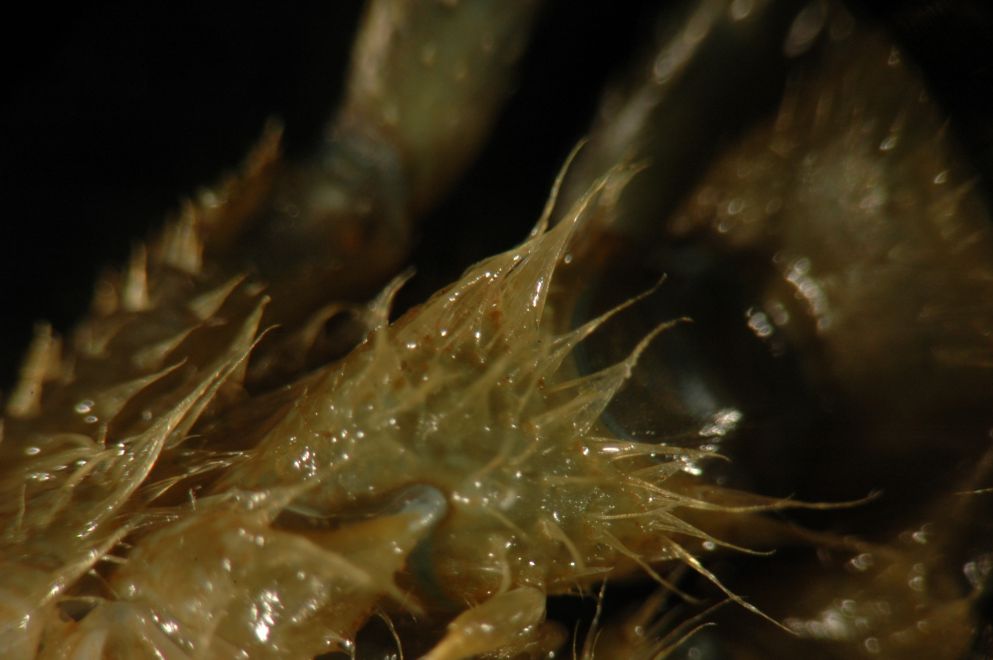
The ventral
surface of the right merus
(center of photo) has one prominent
tubercle
but it is largely obscured by the abundant setae.

This individual jumped out of its shell which was stuck. That
makes it easy to see the abundant body and leg setae.
Photo by Dave Cowles July 2008

This female readily crawled out of her shell even though she is
"berried"
(carrying eggs under her abdomen).
Photo by Dave Cowles at Kalaloch Beach #4, July 2009
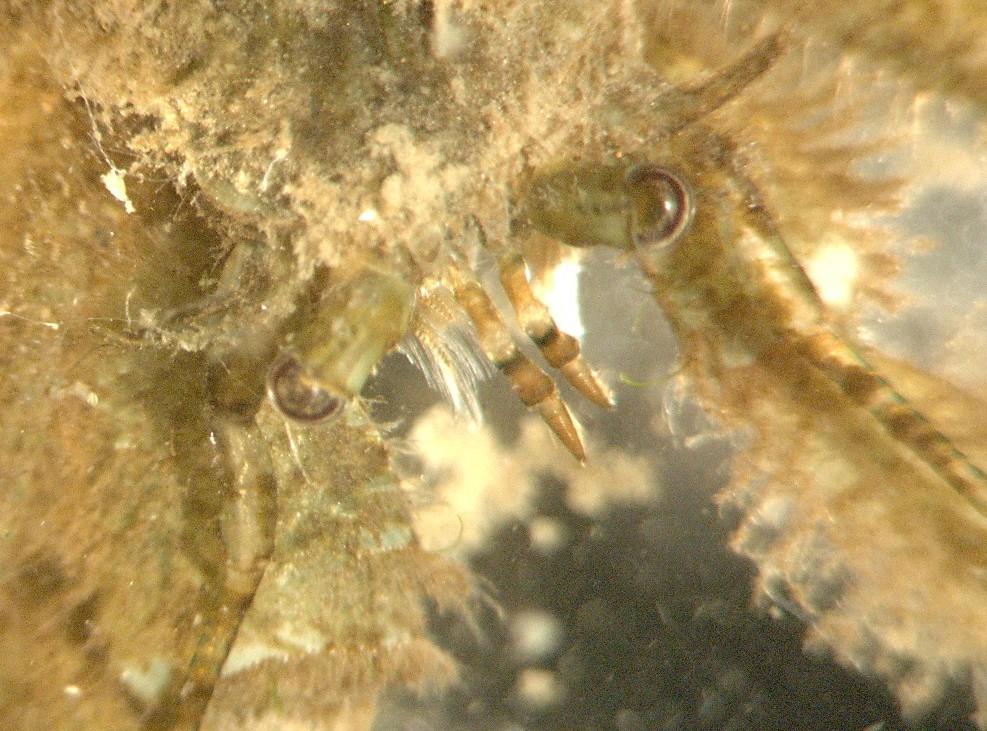
The eyes of Pagurus hirsutiusculus generally seem
to have a
dark crescent-shaped band in them, as can be seen in this closeup
dorsal
view of the head.
Photo by Dave Cowles July 2008
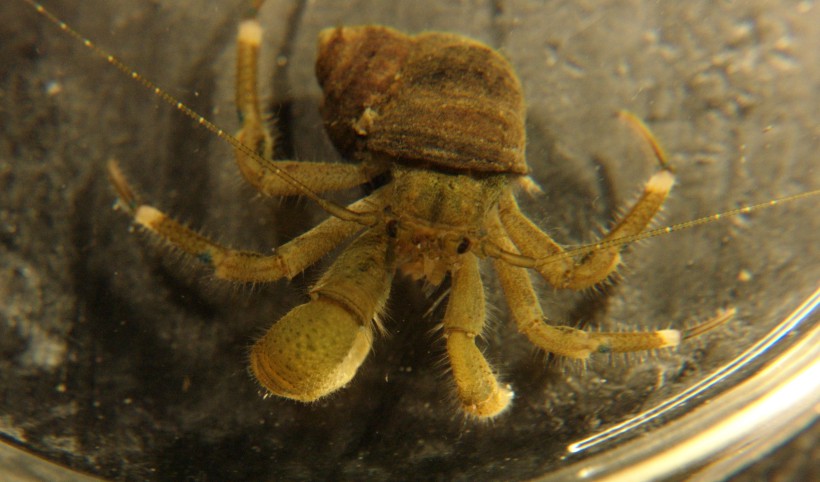
This individual has both white bands and blue spots on the legs. Photo by Dave Cowles, July 2010
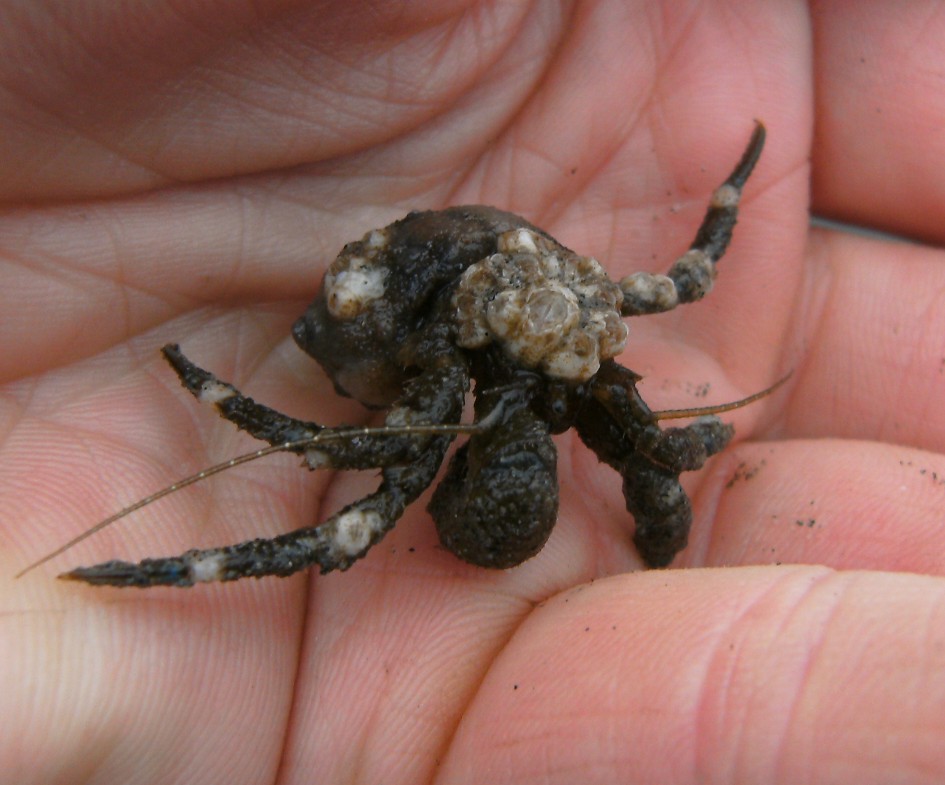 |
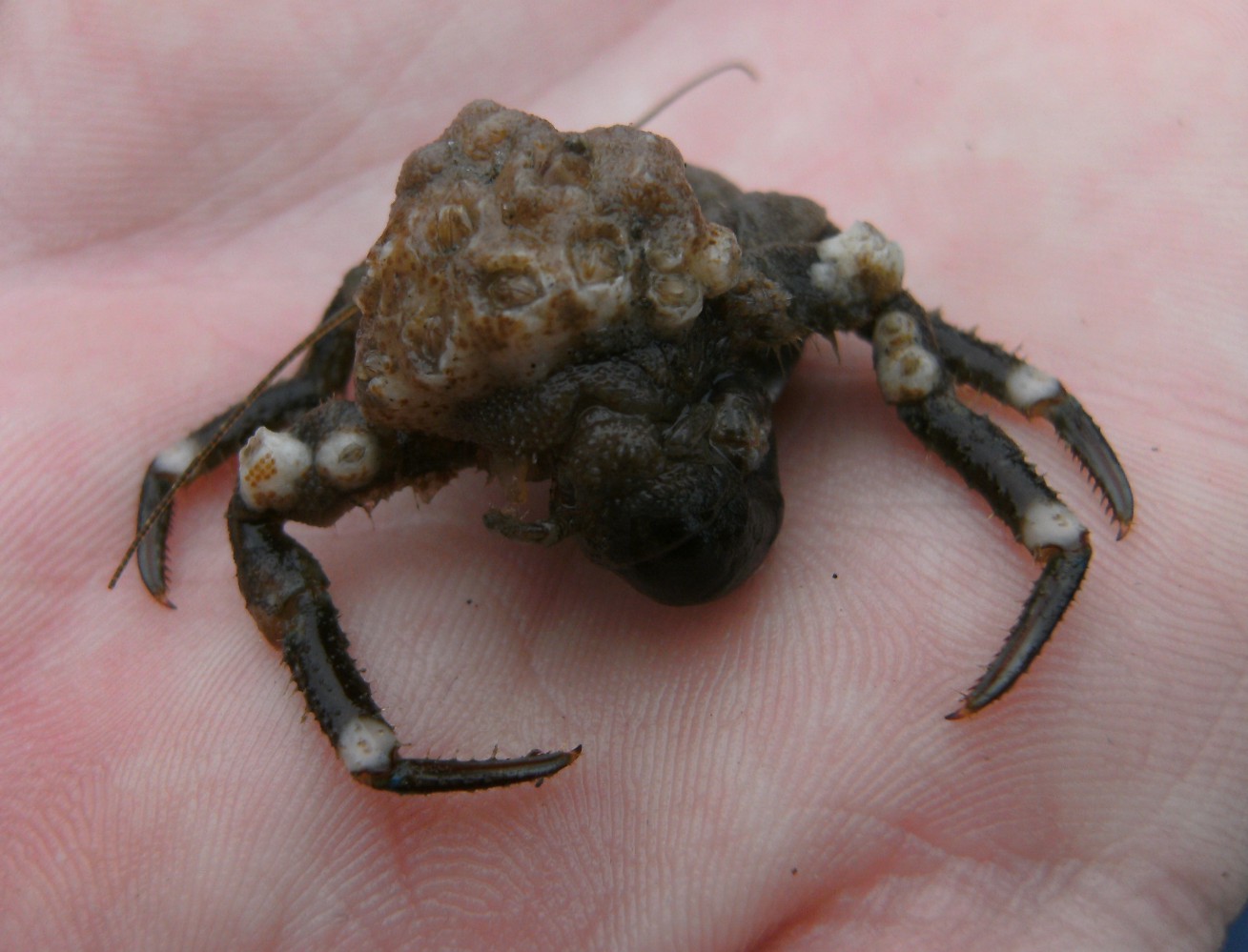 |
| Occasionally individuals are
encountered with barnacles
growing on them. The individual on the left above is carrying
a shell
but has a strong encrustation of barnacles on its carapace
and on several legs. The individual on the right was
encountered
running around without a shell and has a very heavy growth of barnacles
on its carapace and several on its legs. The barnacles appear
to
be so large that it would be difficult for either of these individuals
to find a shell large enough that they could withdraw into, though the
left individual can at least tuck its abdomen into its shell.
Both
were found in tidepools at Beach #4, Kalaloch, WA. Photos by
Dave
Cowles, July 2012. |
|
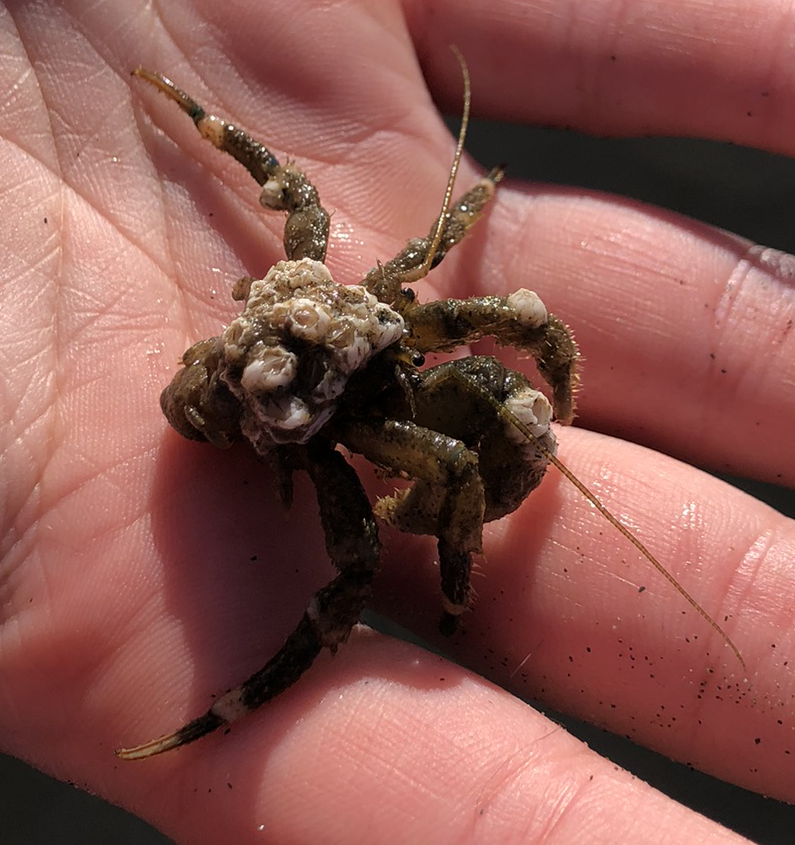 |
|
| Another individual, found at Kalaloch July 2024. Often, finding a crustacean encrusted with barnacles like this suggests that they have a "terminal molt". Crustaceans molt their exoskeleton as they grow, thus shedding any external growths such as barnacles. However, some species reach a terminal molt, often when they become sexually mature (adult). Thereafter, they cannot molt and so cannot shed the barnacles. | |
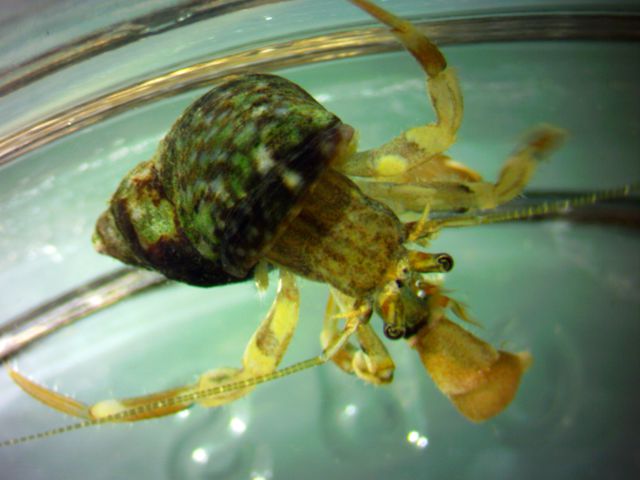
This juvenile, which apparently hitched a ride on something else into
my classroom tank, is small and has few hairy setae
on the legs yet but already is developing the white bands on the distal
ends of the propodus
of the walking legs and the blue spot on the proximal end. It
has
selected a Littorina
scutulata shell, 8 mm long, for its
home. Photo by Dave
Cowles, August 2016.
Authors and Editors of Page:
Dave Cowles (2005): Created original page